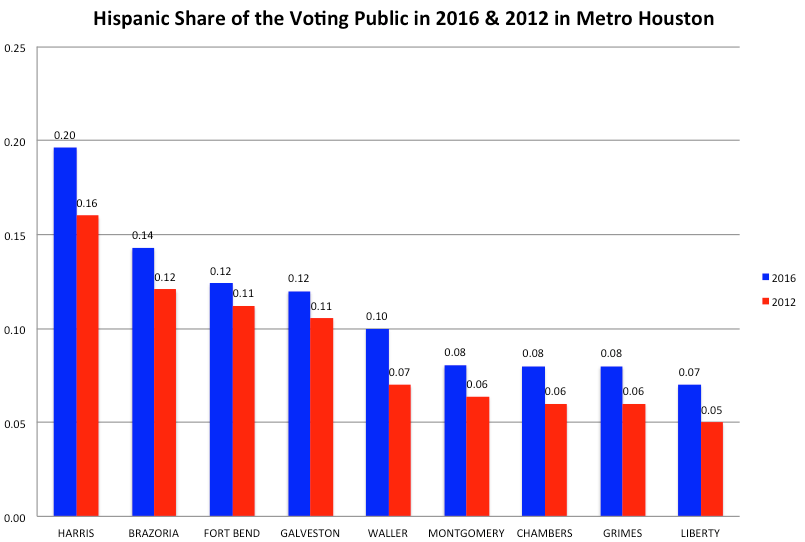Start a Google search with the words "Will Texas turn..." and you'll get a snapshot of political punditry in the suggested autocomplete options.
Will Texas turn blue? Democrat? Purple? In 2016? In 2020?
It's inevitable, the thinking goes, given the state's demographic transformation. Its urban centers, like Houston and San Antonio, were solidly blue in the most recent presidential election.
But as far Texas turning blue, Democrat or purple, that's still a ways off, according to Mark Jones, a political scientist with Rice University and a fellow with the Kinder Institute. "That's happening, but it's at a very slow rate," he said. "It's been pretty modest." Those increases are also muted by confusion over voter identification laws and redistricting that protects Republican seats.
Many observers point to the state's growing Hispanic population, which tends to lean Democratic, as an indication that the political tides will soon shift in Texas. But the Hispanic population's share of the electorate has not kept up.
The state is almost 40 percent Hispanic, representing the third largest population of any state, according to the Pew Research Center. And though Houston and Harris County saw a surge in Hispanic turnout that was credited for the sweep of countywide Democratic victories there in 2016, the reach of the Hispanic electorate was less visible statewide.
 Across the Houston metro area, Hispanic voters represent a growing portion of the electorate. Source: Mark Jones.
Across the Houston metro area, Hispanic voters represent a growing portion of the electorate. Source: Mark Jones.
Only 28 percent of eligible voters in Texas are Hispanic, according to the Pew Research Center. And, though turnout among that population inched up between 2012 and 2016, only 40.5 percent of eligible Hispanic voters made it to the polls in November 2016, according to Census data. Using data from the Texas Secretary of State, though, reveals a slightly higher boost, according to an analysis by the Austin American Statesman. By either measure, Hispanic turnout still falls behind the state's overall numbers. Black, white and Asian turnout were all higher, according to Census data. Once more, it wasn't even a high water mark for Hispanic turnout, according to the Texas Tribune: " last year's turnout is still lower than turnout in the 2004 presidential election."
"There's growth, but in terms of being a formidable voting bloc, it's really only in Bexar County and to a lesser extent Harris County," said Jones of the metropolitan counties surrounding San Antonio and Houston.
And the growth of the Hispanic population hasn't just translated into gains for Democrats. "Among the Latinos who turn out to vote," said Jones, "Republicans are actually doing pretty well," getting around 30 percent of the vote.
Compounded with redistricting that means that even if there were a blue wave sweeping Texas, Republicans might lose one seat in the state Senate and roughly a dozen in the state House in 2018, said Jones, and Democrats are in for an uphill battle.
And don't forget about the confusion over harsh voter ID regulations that had the most negative impact on Latino voters, according to Jones.
Through survey data, Jones found that though one in five people who didn't vote in 2016 said it was because of a lack of proper identification, the vast majority -- 97 percent -- actually had some form of identification that would have met the regulations. Most of those deterred from voting supported Democratic candidates and Latino voters expressed the most confusion about the law.
"When we think about voter ID laws," argued Jones, "the principal consequence and impact is not keeping people from voting because they don’t have an ID, it's confusing people who do have an ID.”

